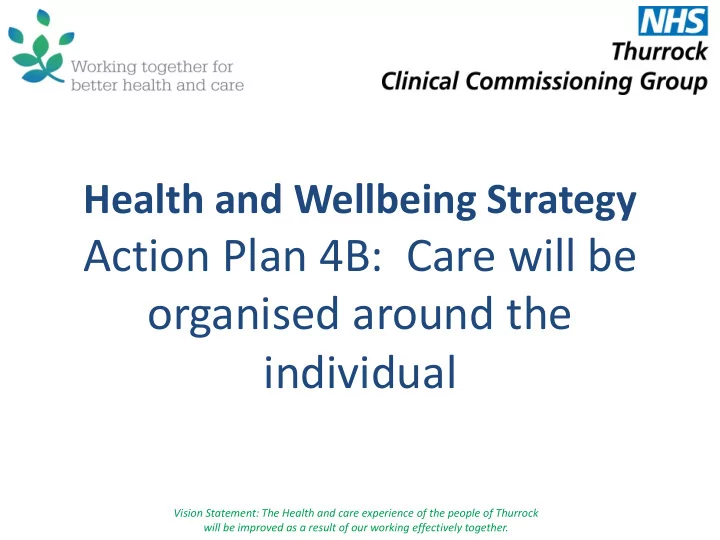

Health and Wellbeing Strategy Action Plan 4B: Care will be organised around the individual Vision Statement: The Health and care experience of the people of Thurrock will be improved as a result of our working effectively together.
For Thurrock in Thurrock Transformation – Recap Public Engagement For Thurrock in Thurrock Wrapping services around our localities - 4 localities + TCH Regen. Healthwatch Thurrock For Thurrock In Thurrock Report Engaging with Thurrock Residents on Transformation Plans: For Thurrock in Thurrock Healthwatch Thurrock Engagement October 2016 Using Risk Stratification Enhanced Integrated Care New Care Paradigm Supporting people like Beryl New Care Paradigm for Older People & Frailty TOMORROW TODAY “ An older person living with ‘ The Frail Elderly ’ frailty" (i.e. a label) (i.e. a long-term condition ) Timely identification for Presentation late & in crisis preventative, proactive care by (e.g. delirium, falls, immobility) supported self-management & personalised care planning Community-based: person- Hospital-based: episodic, centred & co-ordinated disruptive & disjointed (Health + Social + Voluntary + Mental Health)
Case Finding and Risk Stratification - NHS England Definitions • Case finding is a systematic or opportunistic process that identifies individuals (e.g. people with COPD) from a larger population for a specific purpose for example, ‘Flu vaccination • Risk stratification is a systematic process that can be used for commissioning as it divides a population into different bands of risk for a specified outcome, e.g. unscheduled admission to hospital • These concepts combine in risk stratification for case finding, which is a systematic process to identify sectors of the population that may benefit from additional clinical intervention, as directed by a lead clinician such as the patient’s GP.
Understanding Risk Stratification Case finding and risk stratification - how to understand specific sectors of a population and provide person-centred care to those most in need Proportion alive
Frailty and EOL Out of Hospital Transformation: For Thurrock in Thurrock • Risk Stratification: use of the Electronic Frailty Index (eFI) promoting early identification and assessment of Severe (EOL), Moderate to Mild Frailty • Alignment of Multi Disciplinary Teams: to support the outcome of risk stratification, better coordinated care and escalation planning, and alignment of Named Accountable Professional dependent on need
Care and Support Planning Care and Support Planning Professional Person ’ s Story Story Information gathering Information Sharing Goal Setting and Action Planning Agreed & shared ‘ care plan ’ Year of Care
Frailty and EOL Out of Hospital Transformation: Early indications in Thurrock Risk Stratification: • The Electronic Frailty Index is now being used in one-third of Thurrock GP Practices to identify and assess need • Use of the Electronic Frailty Index to identify and assess need with one Thurrock practice has highlighted that 25% of the people identified as living with frailty were not already known to the health and social care system - potential A&E attends/admits if left unidentified and unmanaged.
New Care Paradigm for older people and frailty New Care Paradigm for Older People & Frailty TOMORROW TODAY “ An older person living with ‘ The Frail Elderly ’ frailty" (i.e. a label) (i.e. a long-term condition ) Timely identification for Presentation late & in crisis preventative, proactive care by (e.g. delirium, falls, immobility) supported self-management & personalised care planning Community-based: person- Hospital-based: episodic, centred & co-ordinated disruptive & disjointed (Health + Social + Voluntary + Mental Health)
For Thurrock in Thurrock … Locality based services 21 st Century Healthy Living Centers Basildson and Thurrock Hospital Corringham Purfleet Tilbury Thurrock Community Hospital
Key barrier to this vision: Data Integration SystmOne SEPT BTUH NELFT Adult Social Care GP Others?
Implications of not integrating health and social care data Repeatedly gives the same information to different people Care is reactive not proactive Cared for by different people who don’t have all the information they Care is not holistic or need person-centred Waits for care Gets “stuck in the system”
Identifiers Identifiers Mental Health Social Care Commissioning Identifiers Identifiers Primary Care Acute Hospital 0100101101110000 010010110111000011010010 010010110111000011010110010010 010010110111101000011010100110100 01001011011110100001101010011010010010 010010110111101000011010100111101001000101010101011101001001000110 010010110111101000011010100110100100101100011000010111100001100101100 01001011011110100001101010011010011100011011001001001110010100101101 010010110111101000011010100110110001101011110000110010010010 01001011011 1101000011010011011010011000 0100101101111010000 010010110111 Rich Linked Data Set Overnight updates Trusted 3 rd Party Key Vault Pseudo-anonymised
From my perspective the data allows the identification of individuals who have characteristics that mean they might benefit more from specific interventions. Although this can be done with the type of tool within a GP system, by using multiple provider data this can be enhanced e.g social care current and previous input, community care plans, ambulance call outs From a commissioner point of view it allows creating new ways of aligning data which then allows greater understanding along a care pathway e.g. how often do our diabetic patients access hospital care and community service. That way we can create richer cohort data and understand how costs can be attributed to groups of patients. It allows development of services to meet specific needs. That aim being to focus on cohorts deemed at "rising risk" and wrap services around or provide specific interventions to try and avoid move into a high risk cohort. It than allows tracking by population whether you are achieving changes. Dr. Jane Moss, West Essex CCG
Next Steps Final amendments to service specification Start formal procurement process 21/09/2016 Selection of preferred supplier – early December “Proof of concept” stage Phased approach to mobilisation
Recommend
More recommend